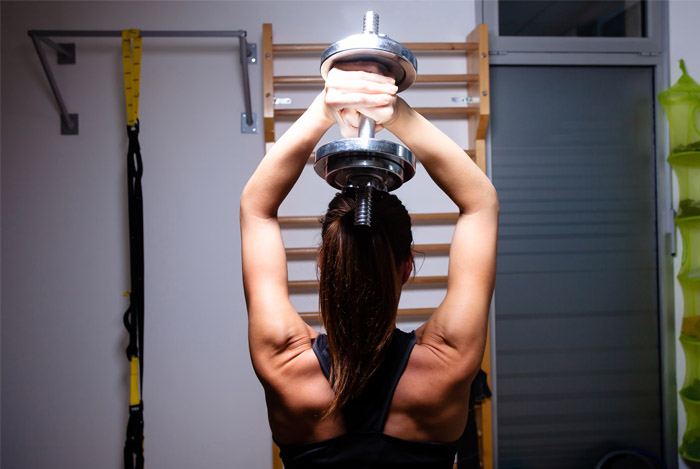7 Most Common Workout Mistakes
It is well known that working out reduces the risk of heart attacks, cancer, and depression.
In addition, it also helps you feel better both on a physical and mental level.
It goes without saying that physical activity of any type, that is to say, working out has many advantages compared to its disadvantages and pitfalls if any.
Nonetheless, it is up to you how your workout session will look like.
Furthermore, even though there are even experienced fitness coaches that are prone to making some basic mistakes, beginners are those who need to be given a helping hand and some advice.
Just like in an everyday life routine, it is difficult to weed out the habits that have already taken the root.
Hence, you should be given instructions on how to define your workout sessions as best as possible.
If you are working out on your own without the help of a fitness coach or instructor, make sure you get to know some most common mistakes people make.
This will prevent you from repeating these mistakes, thus improving your workout sessions and making more progress.
In this article, I am going to present to you 7 most common workout mistakes.

Mistake #1: Not Defining Your Workout
How many times have you seen people who the moment they change their clothes go to the bench press, put some heavy weights and start lifting right away?
On the other hand, you have probably been a witness of people avoiding warming up because they find it time-consuming and ineffective for their muscle growth.
No matter what your goals are, each your workout session should include 3 phases: the warm-up phase, the main phase, and the stretch-out phase.
The most common people’s motive to start working out is because they want to improve their physical appearance.
The health and all other benefits come second.
Therefore, people often concentrate on doing only the main part, ignoring the pre- and post-workout exercises, believing that warm-up and stretch-out are not helpful in terms of physique and muscle building.

Mistake #2: Skipping Warm-Up
The warm-up activity prepares our nervous system for the upcoming physical stress.
It also prevents skipped heartbeats and premature fatigue.
In addition to this, the warm-up phase is most necessary when doing HIIT (high interval intensity training) exercises such as sprinting or Crossfit.
Namely, if you were to run 10 rounds of 50 m sprints and you were not physically prepared, that is, warmed up, there is a high likelihood for strains, sprains, and other muscle injuries.
On the other hand, even if you are doing a moderate intensity workout exercises, warming up will get your blood flowing faster through the entire body, which helps your muscles to pump up in an easier way.
Leaving aside your workout routine, you should always warm up your entire body.
Five to ten repetitions is everything you need.
Start from your head with neck rolls and then progressively go down your body with shoulder shrugs, arm circles, trunk twists, and squats.
Warm-up exercises, however, may vary depending on your workout routine.
Let’s say you are a gymnast.
What you should take notice of are your joints.
Make sure that you perform mobility exercises that will increase the range of motion in your joints, thus preparing them for your workout.

Mistake #3: Incorrect Form
You have probably caught many people complaining about lower back pain after deadlifts or joint pain after box jumping.
But it is believed if you feel pain after a workout, it must be muscle soreness and it must be something good.
However, you should make a clear distinction between joint pain and muscle soreness.
The former compromises your body’s ability to perform properly while escalating your risk of injury.
Done incorrectly, any exercise can lead to injury.
That being said, even though you see people working out with the incorrect form and without consequences, there will be some down the line because not always does incorrect form affects our body presently.
If your workout is not giving you the results you want, a poor form is to blame.
It stands to reason that you will end up with some results, but you will probably be disappointed with them for they will be poor.
Therefore, make sure that before you begin with any of your workout routines, you get some guidance on how to perform each exercise in a correct form.
It is the quality of your training that is the most influential to your progress, more than the quantity.
So, if you want to improve your workout routine quality, you have to be mentally focused during every exercise you perform.
Going half-heartedly through the motions is the road to nowhere because your results decrease and the risk of injury increases.

Mistake #4: Sticking to the Same Workouts
Does your workout bore you and is no longer challenging?
You cannot see the results and it begins to make you more tired and sore?
These are just a few symptoms that it is high time you changed your workout routine and plan.
Needless to say, building a workout routine will boost your confidence, which will ultimately lead to the better results.
Nevertheless, repeating your workout routine and performing the same movement patterns on a regular basis will jeopardize your goals.
The reason for this is our body uses the least amount of energy and gets accustomed to the movement patterns, which results in reduced calorie burn and muscle building.
There are numerous ways to alter your workout routine.
It is not just the exercise selection that you can alter.
Take into consideration the number of sets per exercise, the number of reps per set, or the exercise order.
For example, if you are a jogger, change your route by either increasing or decreasing a distance or speed.
This way, your body will have to adapt to the new conditions you have set, prompting it to burn more calories.
On the other hand, if you are in a gym, you might want to stop doing overhead shoulder press using the smith machine.
Replacing it with just dumbell shoulder press exercise will affect your body tremendously.

Mistake #5: Concentrating on a Single Body Area
Your body is a complex machine, a composition of symmetry, functioning on multiple levels that are intermingled and inseparable.
Within these levels, there are sublevels, in this case, the neurophysical and muscular system.
Focusing on one level only will cause an imbalance in your entire body. Accordingly, focusing on one individual muscle growth, isolating muscles, and excluding others will reduce your body balance, increase weaknesses, and stop you from achieving your desired figure.
Keeping your body focused on single areas will also increase injury risks.
When people concentrate on a particular body area or muscle, it is usually because it is the part they can see in the mirror.
For guys, it’s normally a combination of chest exercises, biceps curls, and knee extensions; for the women, it’s all about the inner and outer thighs, abs, and back of the arms.
Even though these are just stereotypes, it is not far from the truth.
High-intensity exercises are the problem solver in this case.
These exercises help your body to create muscle definition all over it.
High-intensity exercises recruit all types of muscle fibers: slow-twitch fibers, intermediate fibers, and fast-twitch fibers.
By recruiting all of these 3 fiber types, your body will be more effective and have a better-looking physical appearance.
Additionally, core stability (stability of the spine) is very important because it gives you the strength that allows you to perform workout exercises without the risk of injury.
Core stability prevents back and other peripheral injuries. One of the best exercises for core stability is a plank.

Mistake #6: Over-training
Before taking a strenuous exercise, you should acknowledge the limits of your body.
In the long run, over-training does more harm than good.
It is a common belief that if you hit harder that heavy iron in the gym or run a longer distance than that you planned, the results will be better since you gave your best.
However, this is principally a faulty belief. What is the crucial mistake that people make when over-training is they do not give their body enough rest.
It is important that your body has enough time to recover from the physical stress.
There are two levels which you should acknowledge when thinking about giving your body enough rest.
The first level is the recovery time of your workout sessions.
This holds water especially in the case of high-intensity workout exercises because high-intensity workouts animate fast-twitch fibers (as mentioned in the previous part of this article) where these fibers take 48 hours to heal and recover completely.
Taking into account the recovery time of fast-twitch fibers, it becomes clear that you should not do more than three high-intensity workouts per week.
If you do, you will certainly feel the symptoms of over-training, which we will list in the next section.
On the other hand, the recovery time between your sets and reps is also an important factor.
If you are pushing a muscle very hard with a high set, rep, and weight exercise, there is a high likelihood that the muscle will suffer from over-training.
To prevent this scenario, try to adapt your body to powerful workout yet muscle-safe sessions, where you gradually increase the intensity and reduce the frequency so as to keep things in balance.
Most common over training symptoms are:
- Exercising exhausts you
- You are feeling sleep-deprived
- You have “heavy” legs
- You experience adrenaline fatigue
- You catch an illness easily

Mistake #7: Skipping Stretch-out
No matter what workout routine you are doing, be it aerobic, gymnastics, or weightlifting, it is essential that you stretch-out after each workout.
In addition, most men spend too much time sitting throughout the day.
This body position leads to some structural changes that are harmful to your body.
Tight hip flexors, tight pecs and tight cervical extensors (the muscles in the back of your neck) are just some of the symptoms of a lack of stretch-out exercises.
Conclusively, stretching out assists you to correct your posture.
While warm-up is normally a pre-workout routine, stretch-out is a post-workout one.
Stretch-out exercises are known for relaxing the strained joints and muscles, increasing flexibility, blood and nutrient supply to muscles, thereby reducing muscle soreness and minimizing the chances of injuries.
However, it is believed that pain is inevitable when doing stretch-out exercises.
This is wrong because ignoring pain means ignoring what your body is telling you.
You should always listen to your body.
Yes, stretch-out entails pain, but over-aggressive and forceful stretches make a situation worse instead of better.
Moreover, try not to rush through your stretch-out exercises.
Make sure you do every single one thoroughly, with each repetition trying to go a little further.
When you start to feel pain and over-stretched, that is the indication you should stop pushing it to the limit right away.
Do not forget to breathe.
Holding breath while stretching out actually tightens your muscles.
Deep breaths cause relaxation in your muscles, especially when you breathe out, causing you to release tension.

Conclusion
I argued at the beginning of this article that workout is very helpful to both your body, mind, and physique.
Every human being is able to work out on their own; nonetheless, it requires a certain degree of either self-education or professional help.
If you are in no position to have a personal fitness coach, articles such as this one may help you become familiar with your potential beginner mistakes.
Since you are not taking workouts every single day (we mentioned why 7 workouts per week is a wrong thing), dedicate that time during the rest days to bringing your workout sessions to the next level.
FDA Compliance
The information on this website has not been evaluated by the Food & Drug Administration or any other medical body. We do not aim to diagnose, treat, cure or prevent any illness or disease. Information is shared for educational purposes only. You must consult your doctor before acting on any content on this website, especially if you are pregnant, nursing, taking medication, or have a medical condition.
HOW WOULD YOU RATE THIS ARTICLE?







The biggest # 8mistake is laziness, isnt it?